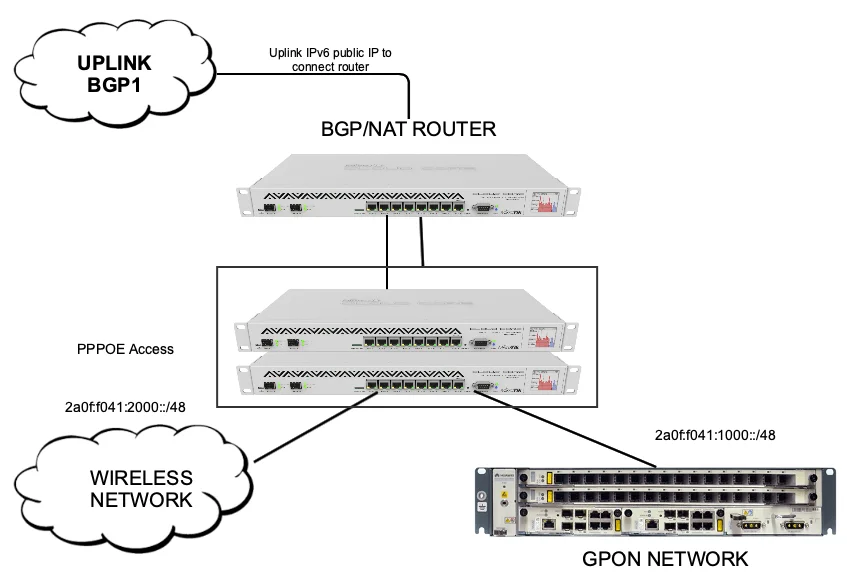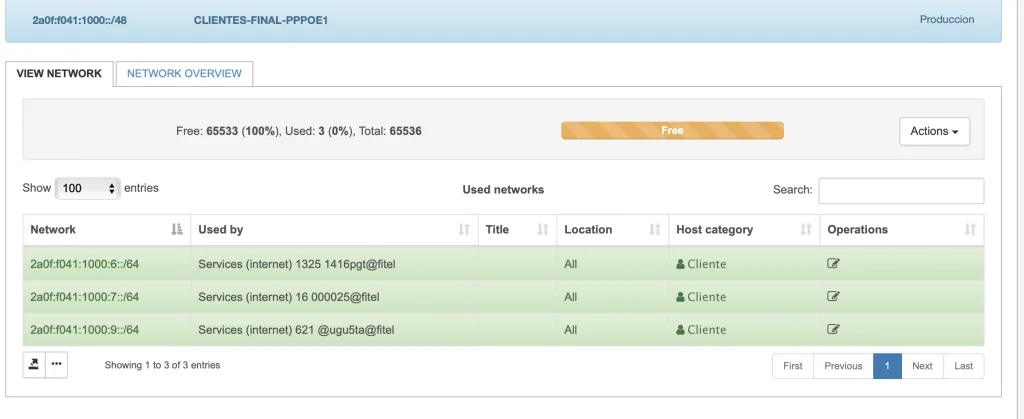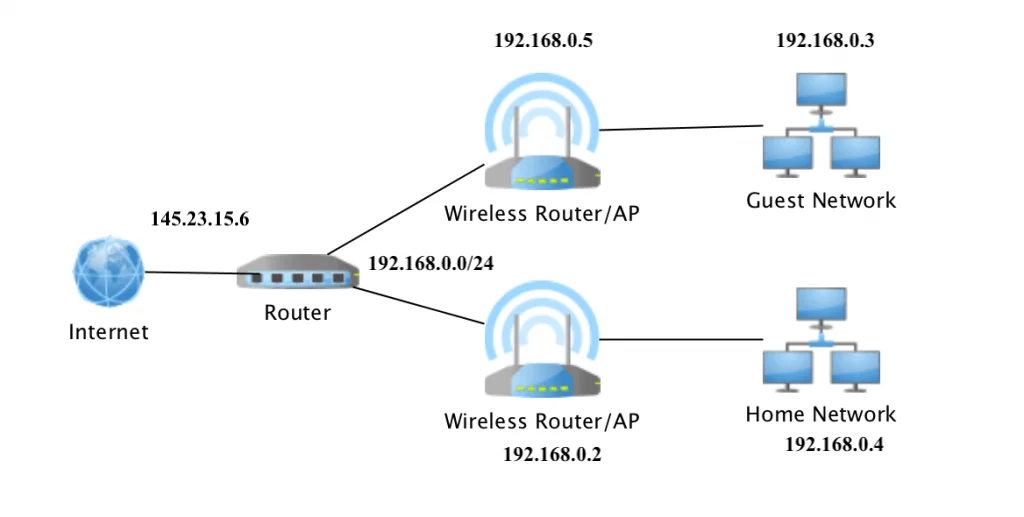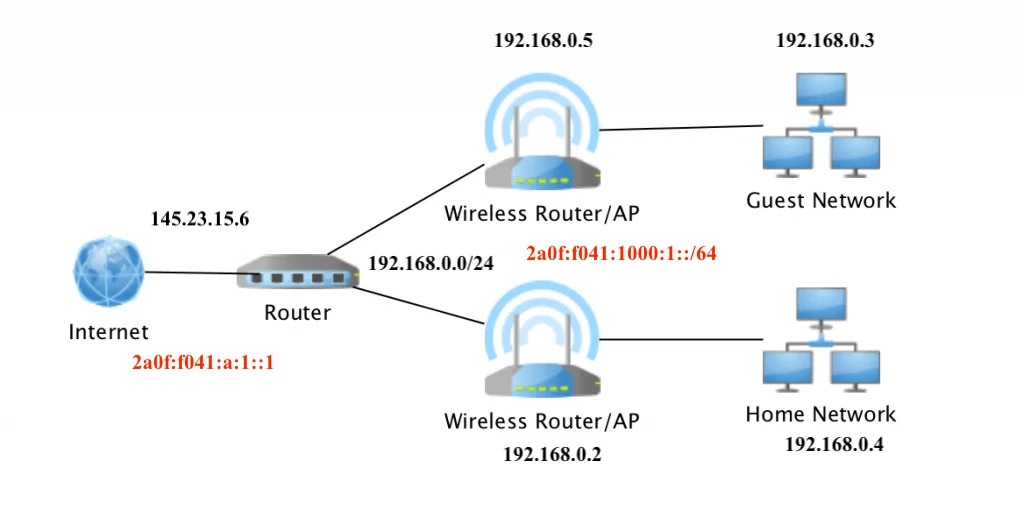



Starting from the 3.0 version, Splynx has native IPv6 support. In this topic we will cover 3 main areas of IPv6 deployment:
If you want to know more about Mikrotik IPv6 configuration or Home router IPv6 configuration, read the following articles:
In Splynx IPv6 management is similar to IPv4 network management. Under “Networking” there is an IPv6 networks submenu with the ability to add networks, show available networks, and display detail of usage of each network.

In the selected example, we have added a /32 IPv6 network. It is the network that is usually assigned to the ISP company by the local registry.
From the /32 network we can choose /48 networks to route them on a certain site or PPPoE concentrator. In total, /32 network consists of 65536 /48 networks. It means that we can have up to 65k different high-sites or PPPoE/DHCP NAS routers. Each NAS or PPPoE server or DHCP server (depends on your topology and authentication method), can connect up to 65k subscribers. Always /64 network is delegated to the end user’s LAN network or his CPE. Inside one /48 IPv6 network there are 65536 /64 networks.

There is a disadvantage of using a /64 assignment per CPE because it can be used only on one LAN of the customer’s equipment. Imagine the situation when your customer wants several LAN networks inside his LAN. For example, he has two VLANs, one guest network or similar. Usually, end users don’t require it, but in case they do, you will not be able to provide the service with a single /64 delegated and will need to delegate a larger network, which will allow having multiple /64 per one CPE.
In this scenario and actually best practice IPv6 deployment is to use /40 networks for NASes and /56 networks assign to end-user devices. End user’s CPE will grab one /64 and connects one LAN by default, but if he will need two or more LANs, he will be able to do it without changes in the ISP address plan or routing.
One of these basic IPv6 topology designs we recommend to use inside small and medium-size ISP networks. Of course, there are plenty of other IPv6 planning options that can be found on the Internet, but all these IP plans are quite complicated and just bring more complexity to IPv6 address deployment.
In our example, we have received a network 2a0f:f041::/32 from RIPE NCC.
We decided to dedicate one /48 network to Infrastructure needs – 2a0f:f041:f::/48
PPPoE concentrators will assign IPs from the ranges : 2a0f:f041:1000::/48 and 2a0f:f041:2000::/48.
In case we have more PPPoE servers, we can use IP networks like 2a0f:f041:1100::/48 or 2a0f:f041:1011::/48 or 2a0f:f041:3050::/48.
Actually, we used 4-5 /48 IPv6 networks to cover all our NAS routers and infrastructure. And there are still over 65k IPv6 /48 networks left.
As was mentioned above – customers receive/64 or /56 prefixes. From these prefixes, CPE/home router device creates a pool (similar to IP lan pools in IPv4 world), and IPs from this pool will be assigned to end devices.
Below is an example of how IPv6 appears in Splynx IPv6 networks when a CPE got /64 prefix delegated:

Activation of IPv6 in infrastructure
Okay, we have designed a simple IPv6 address plan, let’s recap what should be done during the first phase of IPv6 deployment:
When all the above is working, we can start with the most tricky part of IPv6 deployment – assignments of IPv6 to the end-users. Mostly everywhere, end users have their own wireless router that connects their devices to the Internet.
Below is the topology of the connection of the advanced home users, which have one router and two access-point bridges with many devices, such as PCs and phones.

As we can see in this topology, the SOHO router has one public IPv4 on its WAN interface and one IPv4 from LAN range 192.168.0.0/24 that is used as a default gateway for all devices at home. It’s obvious that a router acts as a NAT server in this scenario when all customers from home are leaving the LAN network and connect to the Internet from one public IP and all traffic is sent back to the network via this one single public IP address.
The IPv6 world has no NAT. It means that CPE or SOHO/Home router should route public IPv6 network instead of private range. How small home office router will know what IPv6 network it should use and route? This is the job of ISP’s equipment to tell it to the CPE/Home router.
In general, the ISP router assigns an IPv6 address to the WAN interface in the same way as it did with IPv4 address, but also it should assign a “LAN” network. This is called Delegated IPv6 network and it’s the network of mask /64. Below is an example.

In our example, the Home router received one single IPv6 address 2a0f:f041:a:1::1 on the PPPoE-client tunnel and additionally it got a prefix, that is automatically configured on LAN interface 2a0f:f041:1000:1::/64. All IPv6 end devices will receive the IP address with ND (Neighbor discover) technology that is called SLAAC. This is a technology of stateless automatic IPv6 address configuration for end-users that should be used in local area networks.
In Splynx each customer has Internet service, under the settings of this service there are options to assign IPv4 and IPv6 addresses.
The first option “IPv6 network” is for IPv6 assignment to the WAN interface and the second “Delegated IPv6 network” is for the network, that should be used by CPE/Home router inside the LAN network.
Read more:
Find out how Splynx helps ISPs grow
Learn more